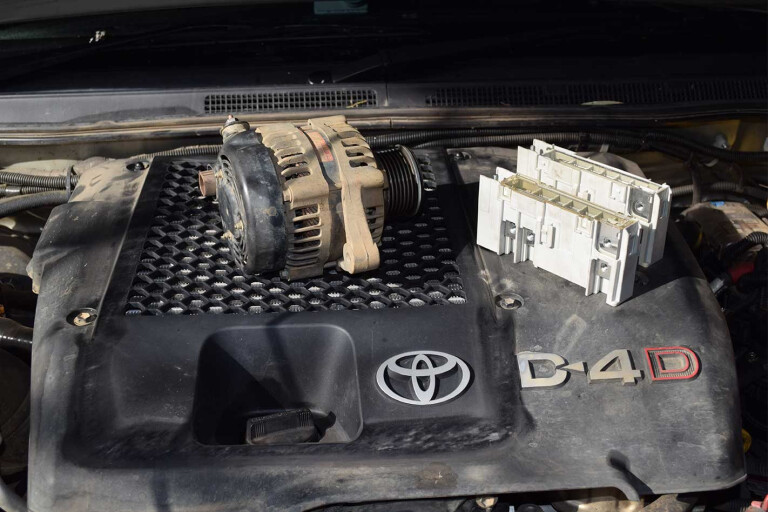
WE WERE stepping off on a six-week run through the mulga, the desert and the Gulf country when, on day one, we struck a problem.
Travelling along the Sturt Highway on the Hay Plain, the entire instrument panel simply turned off. Happily, we had full control, but it was still off-putting.
So we stopped for some roadside diagnosis, where we couldn’t see any blown fuses or other obvious causes. So we gently cruised into Balranald, settled into the town’s caravan park, and went in search of a mechanic. It didn’t take long for the guys at Balranald Diesel Service to identify that the Denso 85amp OEM alternator was shorting and had blown the fusible link.
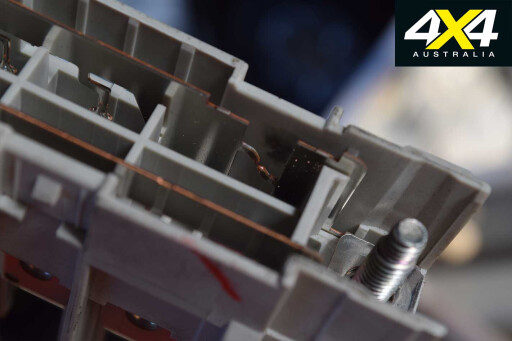 With no suitable spares on hand, parts were ordered from Swan Hill and Mildura. It was pretty obvious we were going to be looking at a layover of more than 24 hours or more, so we headed to the Shamrock Hotel around the corner to reacquaint ourselves with Schnitty Night.
With no suitable spares on hand, parts were ordered from Swan Hill and Mildura. It was pretty obvious we were going to be looking at a layover of more than 24 hours or more, so we headed to the Shamrock Hotel around the corner to reacquaint ourselves with Schnitty Night.
Over beers and dinner we chatted about whether we may have put the alternator under undue pressure, or whether it had simply reached the end of its natural life. After all, an alternator typically lasts around seven years or 100,000km.
For the previous nine years it had happily fed our Redarc BCDC 1240 that served our twin Optima D27F Yellow Top 66amp/h batteries. Since 2013, we’d also connected the unit to our Echo 4x4 Kavango camper, which carries twin Ultimate Xtreme 12V 120amp/h deep-cycle AGM batteries.
In addition to these four batteries, the other obvious accessories feeding off the system were two fridges (a 40-litre Engel in the back tray and an 80-litre ARB in the camper). So while the 85amp OEM alternator seemed small, she’d been doing a decent job … until now.
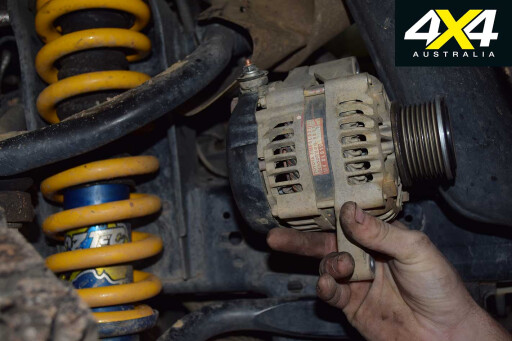 When the only replacement available within a 200km radius was an aftermarket 85amp alternator, we didn’t have much choice but to slot her in and get back on the road. But when the alternator packed-up a second time after just six months (25,000km), we were ready to ask some hard questions.
When the only replacement available within a 200km radius was an aftermarket 85amp alternator, we didn’t have much choice but to slot her in and get back on the road. But when the alternator packed-up a second time after just six months (25,000km), we were ready to ask some hard questions.
We’d hit the Hume Highway for a quick dash up the east coast to catch up with mates for Australia Day, when just two hours from home the charging system warning light came on.
A quick call to the local blokes at Berrima Diesel confirmed that they were closed and booked out the following day, but they suggested we were okay to push on to Mittagong Auto Electrics, 15 minutes down the road. As we travelled, however, it was clear we were dealing with another alternator problem.
The Redarc dual-voltage gauge was tracking the battery’s charge and it was diminishing before our eyes. So we turned everything off and switched on the second battery to link it with the crank battery. It was 5.30pm, two days before a public holiday, and the prospect of getting to Forster any time soon was in real jeopardy.
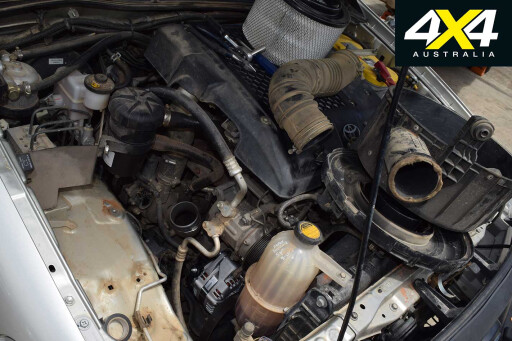 Our spirits improved as we pulled into the electrician’s forecourt and saw the lights on in the workshop. Things were looking up. The guys agreed to check us out the following day and they let us set-up overnight in the carpark.
Our spirits improved as we pulled into the electrician’s forecourt and saw the lights on in the workshop. Things were looking up. The guys agreed to check us out the following day and they let us set-up overnight in the carpark.
A quick look around the vehicle showed only too clearly how much we were expecting of our alternator.
Every 12V port had something plugged into it, either charging or running. This included phones, cameras and a third fridge: a Waeco CDF–11. On top of that, the Engel was set to freeze mode to store meat and ice blocks. Any wonder, then, that the alternator had been overloaded with the flow of high currents causing the stator to wind and heat up. Too excited to get out the door, it seemed we’d blown it – literally.
It was clear the aftermarket 85amp alternator wasn’t comparable to the OEM and unable to cut the mustard under this sort of sustained pressure. The following morning our concerns were confirmed, but luck was on our side. Of the two models of alternators that can be fitted to a 2008 KUN26 Hilux like ours, the Repco store across the road stocked just one. But was it compatible with our needs?
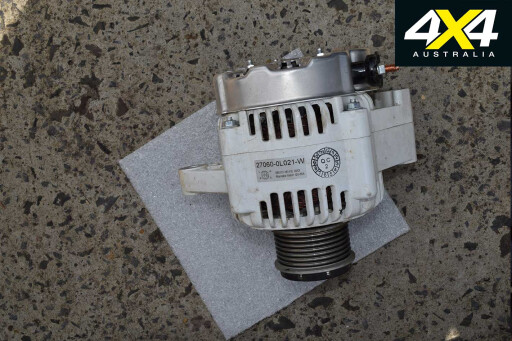 It was much bigger than the 85amp factory-fitted model that was under the bonnet when the rig rolled out of the showroom in 2008, and bigger than the one that was fitted at Balranald six months ago.
It was much bigger than the 85amp factory-fitted model that was under the bonnet when the rig rolled out of the showroom in 2008, and bigger than the one that was fitted at Balranald six months ago.
Enter the OEX DXA552 130amp. This is a light commercial alternator with a further 45amp capacity over our previously installed units. The blokes at Repco knew the OEX DXA552 would be suitable for the Toyota Hilux and Prado, but there’s a trick: different alternator models are made for Hiluxes manufactured in Japan compared to those made in Thailand.
They may look the same, but plug in the wrong one and your warning light will come on almost immediately. So there was a bit of ‘keep your fingers crossed’ involved here.
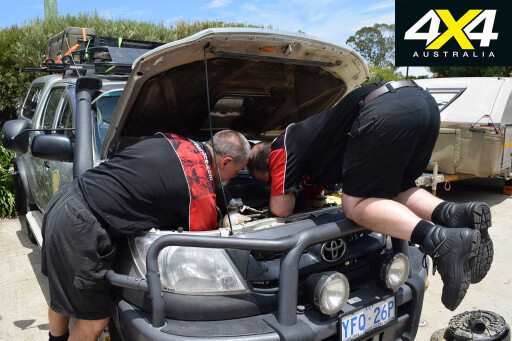 The Balranald 85amp alternator cost around $350, and the more powerful OEX here at Mittagong was about to set us back $488. As for warranty, we’d need to keep an eye on things. For the new OEX alternator we’ve been promised a three-year/90,000km warranty for road use.
The Balranald 85amp alternator cost around $350, and the more powerful OEX here at Mittagong was about to set us back $488. As for warranty, we’d need to keep an eye on things. For the new OEX alternator we’ve been promised a three-year/90,000km warranty for road use.
However, take our 4WD off-road (of course we will) or use it commercially and the warranty drops to 12 months/30,000km/1500 hours.
Once installed we were back on the road and we reached our mates by late afternoon, with plenty of time left for camping and fishing. It wasn’t until we got home again that we had a chance to spend some proper time reviewing the alternator.
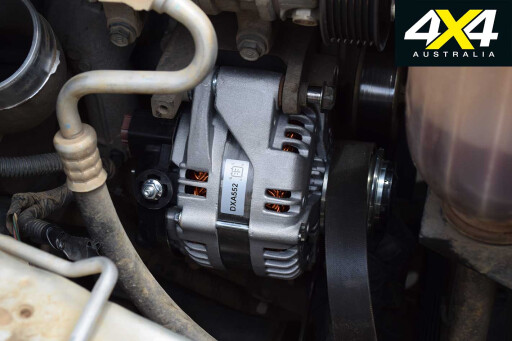 For one, we’ve found that OEX also has a 160amp version that could have been fitted. As for the manufacturer itself, OEX has been around for 20-odd years and boasts the largest range of light commercial units in the Australian and New Zealand markets, as well as a host of models to suit marine, agricultural, heavy-duty, light industrial and passenger vehicles. So this mob is no lightweight in the aftermarket alternator stakes.
For one, we’ve found that OEX also has a 160amp version that could have been fitted. As for the manufacturer itself, OEX has been around for 20-odd years and boasts the largest range of light commercial units in the Australian and New Zealand markets, as well as a host of models to suit marine, agricultural, heavy-duty, light industrial and passenger vehicles. So this mob is no lightweight in the aftermarket alternator stakes.
The units are made overseas, but OEX tests each at its in-house testing facility in Brisbane before they’re released. So, with a decent reputation behind the brand, and with no sign of unwanted warning lights in the 2000km since installation, we’re back on track.

COMMENTS